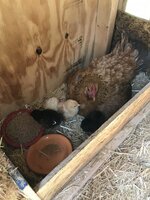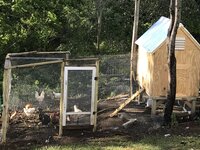Last night we introduced four chicks to their new adoptive mama. All are doing well and happy. I have chick started feed and water in the nesting box but what should I do to make sure my hen stays well nourished? I doubt she will leave the nesting box but I’m not sure if she is eating the chick feed. Any advice is appreciated to next steps too. This is our first time transplanting chicks under a broody hen.
Navigation
Install the app
How to install the app on iOS
Follow along with the video below to see how to install our site as a web app on your home screen.
Note: This feature may not be available in some browsers.
More options
You are using an out of date browser. It may not display this or other websites correctly.
You should upgrade or use an alternative browser.
You should upgrade or use an alternative browser.
Caring for my new mama?
- Thread starter Ddeal
- Start date
Pics
More options
Who Replied?When you grafted the chicks to her did you remove the eggs she was sitting on?Last night we introduced four chicks to their new adoptive mama. All are doing well and happy. I have chick started feed and water in the nesting box but what should I do to make sure my hen stays well nourished? I doubt she will leave the nesting box but I’m not sure if she is eating the chick feed. Any advice is appreciated to next steps too. This is our first time transplanting chicks under a broody hen.
If the eggs are gone, she has no reason to stay on the nest and you should let her take the chicks out.
She will feed the chicks and herself.
Congratulations on what sounds like a total success.
Before a hen even starts to lay she puts on a reserve of fat. This fat reserve is mostly what a broody hen lives off of while sitting on the nest. She will still get up to get something to eat and drink, plus poop. But she can spend most of her time taking care of the eggs instead of looking for food and water.
I don't provide food and water in the nest so your conditions are different than mine. When the eggs start hatching my broody hens do not leave he nest until thee hatch is over. That may be 24 hours after the first one hatches, it may be three full days. Once she decides the hatch is over she brings her chicks off the nest and leads them to food and water. Since the chicks absorb the yolk before hatch they can go three full days without food or water.
If she feels hungry she will eat the chick feed. Since she is not laying eggs she does not need the extra calcium in Layer and chick feed is generally fairly high in protein. It is the perfect food for the broody hen.
Broody hens know more about this process purely by instinct than poultry science professors that study these things in great detail. I mainly try to stay out of my broody's way. When mine start hatching I out food and water on the coop floor where the broody can lead the chicks to them when she is ready. That's all I do. I let her decide when to bring them off the nest and what to do with them afterwards.
Others manage it differently. Some people like to try to micromanage the whole process. They may have different conditions so that might make sense for them. But I find the more I interfere the more harm I'm likely to do.
Before a hen even starts to lay she puts on a reserve of fat. This fat reserve is mostly what a broody hen lives off of while sitting on the nest. She will still get up to get something to eat and drink, plus poop. But she can spend most of her time taking care of the eggs instead of looking for food and water.
I don't provide food and water in the nest so your conditions are different than mine. When the eggs start hatching my broody hens do not leave he nest until thee hatch is over. That may be 24 hours after the first one hatches, it may be three full days. Once she decides the hatch is over she brings her chicks off the nest and leads them to food and water. Since the chicks absorb the yolk before hatch they can go three full days without food or water.
If she feels hungry she will eat the chick feed. Since she is not laying eggs she does not need the extra calcium in Layer and chick feed is generally fairly high in protein. It is the perfect food for the broody hen.
Broody hens know more about this process purely by instinct than poultry science professors that study these things in great detail. I mainly try to stay out of my broody's way. When mine start hatching I out food and water on the coop floor where the broody can lead the chicks to them when she is ready. That's all I do. I let her decide when to bring them off the nest and what to do with them afterwards.
Others manage it differently. Some people like to try to micromanage the whole process. They may have different conditions so that might make sense for them. But I find the more I interfere the more harm I'm likely to do.
- Thread starter
- #4
When you grafted the chicks to her did you remove the eggs she was sitting on?
If the eggs are gone, she has no reason to stay on the nest and you should let her take the chicks out.
She will feed the chicks and herself.
We did take the ceramic eggs out when we put the chicks in. My concerns are keeping the chicks warm. We live in Maine and they are in a outside coop. It’s only 65 degrees outside today. So far the hen is staying in the nesting box. Also, should they be contained in an area. Our coop is off the ground and if the hen leaves I’m afraid the babies will follow and fall. I attached a pic of our coop.
Attachments
She will keep the chicks warm so you don't have to worry about that.We did take the ceramic eggs out when we put the chicks in. My concerns are keeping the chicks warm. We live in Maine and they are in a outside coop. It’s only 65 degrees outside today. So far the hen is staying in the nesting box. Also, should they be contained in an area. Our coop is off the ground and if the hen leaves I’m afraid the babies will follow and fall. I attached a pic of our coop.
Your setup isn't great for a broody hen to raise chicks in.
The ramp is too steep for them.
You could trying tacking down a piece of scrap carpet on the ramp so the chicks could walk up and down it.
I would just leave her to it.
I feed fermented feed and an afternoon mash made from Flock Raiser so it was very easy for my broody to take a clump of wet food out of the trough and break it up and drop it for the chicks to eat.
What are you feeding the rest of the flock?
On a side note, you might want to think about expanding your run. Do you have enough room in your coop for these new additions or are you planning to cull some of your older hens?
- Thread starter
- #6
She will keep the chicks warm so you don't have to worry about that.
Your setup isn't great for a broody hen to raise chicks in.
The ramp is too steep for them.
You could trying tacking down a piece of scrap carpet on the ramp so the chicks could walk up and down it.
I would just leave her to it.
I feed fermented feed and an afternoon mash made from Flock Raiser so it was very easy for my broody to take a clump of wet food out of the trough and break it up and drop it for the chicks to eat.
What are you feeding the rest of the flock?
On a side note, you might want to think about expanding your run. Do you have enough room in your coop for these new additions or are you planning to cull some of your older hens?
Thanks for the tip about the carpet. My husband reworked the ramp to make it a little less steep but I do still have some concerns. I feed the flock a combo of laying pellets and crushed corn. This is the first I’ve heard of the wet food though. Interesting! We are expanding the run and plan to cull about 4 hens that are older and no longer laying in late fall. Didn’t want to do it at the same time of the chicks to avoid too many changes messing with the other chickens. I really appreciate the help. It can be overwhelming to do this for the first time.
Thanks for the tip about the carpet. My husband reworked the ramp to make it a little less steep but I do still have some concerns. I feed the flock a combo of laying pellets and crushed corn. This is the first I’ve heard of the wet food though. Interesting! We are expanding the run and plan to cull about 4 hens that are older and no longer laying in late fall. Didn’t want to do it at the same time of the chicks to avoid too many changes messing with the other chickens. I really appreciate the help. It can be overwhelming to do this for the first time.
I'd like to recommend that you convert the flock over to something like Flock Raiser, All Flock or even keeping them on chick starter. Any complete feed with 18 - 20% protein and 0.8-1.3% calcium. Keep a full container of oyster shell on the side at all times for the active layers. This way, everyone has appropriate food and you don't have to worry about excess calcium and insufficient protein in their diets.
Mixing the corn with the layer dilutes the already minimal protein content and that can have a number of undesirable health and behavioral outcomes.
New posts New threads Active threads
-
Latest threads
-
-
-
May be overreacting- wobbly Bantam chicks
- Started by newchickychick
- Replies: 3
-
-
-
-
Threads with more replies in the last 15 days
-
-
-
-
-
Open Contest Official BYC Poultry Caption Contest 05-23-25 Pic by AidKD
- Started by TwoCrows
- Replies: 67
-
×






